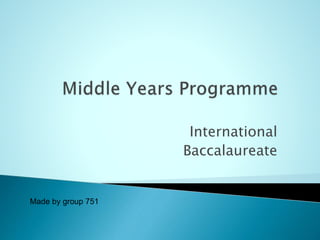
IB presentation "Middle years programme"
- 2. Control of curriculum – national systems Adaptation of school’s own curriculum Teaching in many languages
- 3. 11-16 years Flexible framework that meets demands of national, regional or local legislation The learner is in the centre of the programme 5 areas of interaction
- 7. Provide the MYP with its unique core. Teaching subject areas through these contexts allows to focus on attitudes values skills
- 8. exploration of real-world issues higher-order thinking skills from academic knowledge to thoughtful action interdisciplinary approach to learning the contexts for the MYP fundamental concepts and the IB learner profile positive attitudes and a sense of personal and social responsibility reflection common language framework for student inquiry
- 10. Areas of interaction Health and social education Approaches to learning (ATL) Human ingenuity Community and service Environments
- 11. • How do I learn best? • How do I know? • How do I communicate my understanding? •How do I learn best? •How do I know? •How do I communicate my understanding? • teaching students how to learn effectively • enable them to take responsibility for their own learning • support student achievement • ensure that students acquire the skills and the confidence to take ownership of their own learning • any new skills should be taught explicitly • analyze from the student’s point of view
- 12. • How do we live in relation to each other? • How can I contribute to the community? • How can I help others? • fosters development of the adolescent • the place and role of the student in communities • responsible citizenship • make connections between their development and the benefits that they can bring to the community • the fundamental concept of intercultural awareness - empathy and respect • tools that guide the reflection and allow for formative assessment of student action
- 14. encompasses a range of issues and how they affect individuals, human development and interactions provides students with opportunities to inquire key aspects of human development 4 different levels: • ourselves in the wider society • ourselves and others • understanding ourselves • looking after ourselves. Student learning expectations in terms of: • an awareness of and understanding of contemporary and historical social issues • reflection on and having opinions • making considered and responsible choices • How do I think and act? • How am I changing? • How can I look after myself and others?
- 15. • What are our environments? • What resources do we have or need? • What are my responsibilities? Students will come to an appreciation and understanding of their effects on their environments: • The natural environment • The built environment • The virtual environment • students should develop an awareness and understanding of a range of environments and their qualities • develop awareness through investigation, discussion and debate • students will come to understand better their responsibilities towards their environments
- 16. • Why and how do we create? • What are the consequences? Human ingenuity = the way in which human minds have influenced how we think, work, play, construct and conduct friendships and other relationships, interact with each other, find solutions to problems, cause problems, transform things and rationalize thought.
- 17. Learning Experiences value learning make learning goals explicit accommodate learning styles collaborate with each other inquire into subject content interact with the environment
- 18. Learning is in context Context is relevant Values and expectations are explicit They can learn collaboratively Learning environment is provocative There is a culture of curiosity at the school
- 19. Increased emphasis on Using a rage of teaching strategies Working collaboratively Viewing Ss as thinkers Involving Ss in learning Decreased emphasis on Teaching about responsibility Viewing the teacher the sole authority Viewing Ss as passive recipients Focusing on what Ss do not know
- 20. Proved secure learning environments Strive to develop relationships between teachers, students and parents Develop classroom environments that are focused on learning
- 23. = a document that describes what will be taught in each subject to each age group. Curriculum development Subject content Contexts
- 24. equal emphasis is given to methodology and to planning teaching and learning should emphasize the active construction of meaning encourages teachers to provide opportunities for students to build meaning and refine understanding through structured inquiry The structuring of new experiences by teachers, and the support teachers give to students’ ideas about new experiences, are fundamental to students’ conceptual development
- 25. Internal assessment • tasks are designed, developed and applied by teachers working with students in their schools. Criterion-related assessment • based upon pre- determined criteria that all students should have access to. External assessment • align the assessment requirements of the national or other system with the MYP
- 26. ◦ support and encourage Ss ◦ inform, enhance and improve the teaching process ◦ promote positive St attitudes towards learning ◦ promote a deep understanding ◦ promote the development of higher-order cognitive skills ◦ reflect the international-mindedness of the programme ◦ support the holistic nature of the programme
- 27. Observation Selected response Open-ended tasks Performance Process journals Portfolio assessment A note on standardized tests Assessment strategies Assessments tasks
- 28. Assessment tools Anecdotal records Task-specific clarifications Checklists Continuums Rubrics Examples holistic rubrics Developing rubrics Clarifying published criteria in year 5
- 29. is considered throughout the processes involved in planning for learning the assessment model gives both teacher and student reliable and valid information on the actual learning that takes place for each student MYP assessm ent criterion- related model assessment criteria subject- group objectives
- 31. People Coordinator Subject Leaders Constituents Supervisors